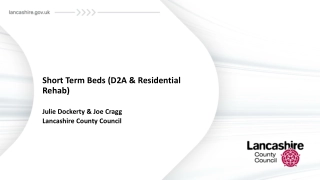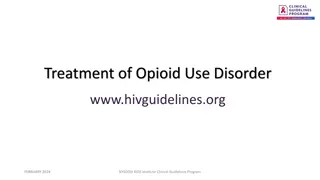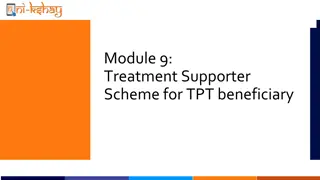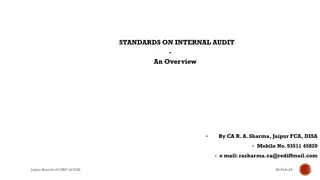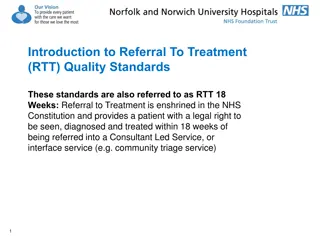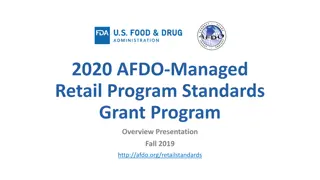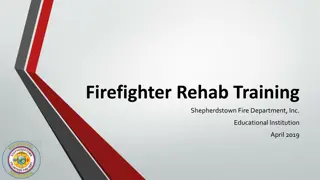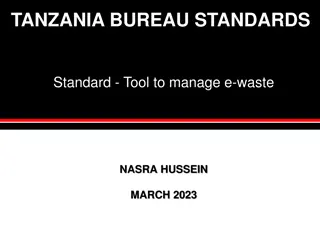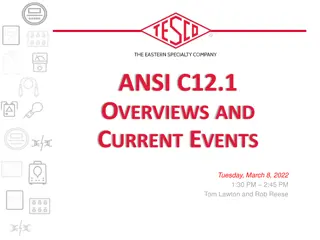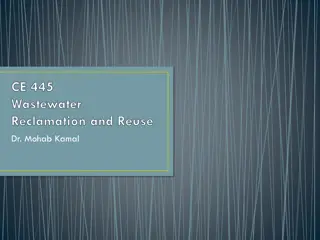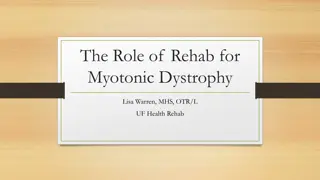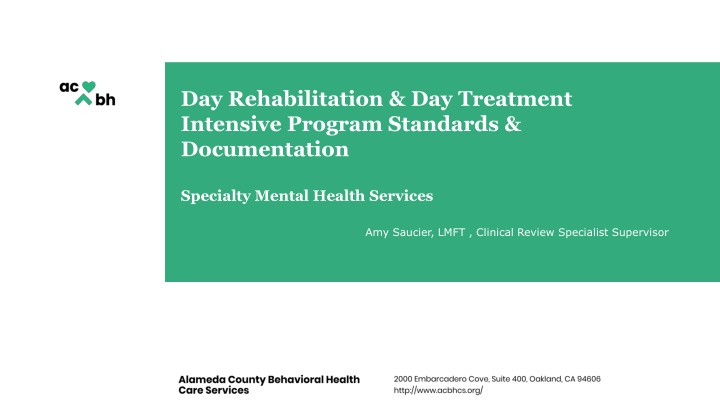
Day Rehabilitation and Treatment Intensive Program Standards Overview
Explore the standards and components of Day Rehabilitation and Treatment Intensive programs, including authorization requirements, documentation standards, and required service components. Learn about the program definitions, authorization process, and clinical quality review team responsibilities in this comprehensive guide.
Download Presentation

Please find below an Image/Link to download the presentation.
The content on the website is provided AS IS for your information and personal use only. It may not be sold, licensed, or shared on other websites without obtaining consent from the author. If you encounter any issues during the download, it is possible that the publisher has removed the file from their server.
You are allowed to download the files provided on this website for personal or commercial use, subject to the condition that they are used lawfully. All files are the property of their respective owners.
The content on the website is provided AS IS for your information and personal use only. It may not be sold, licensed, or shared on other websites without obtaining consent from the author.
E N D
Presentation Transcript
Day Rehabilitation & Day Treatment Intensive Program Standards & Documentation Specialty Mental Health Services Amy Saucier, LMFT , Clinical Review Specialist Supervisor
Learning Objectives Contents At the conclusion of this presentation, participants will be able to describe the: Program Definitions Authorization Requirements and Process Program components that have been established by DHCS for Day Rehabilitation and Day Treatment Intensive programs. Authorization requirements and process. Documentations standards. Claiming Exceptions. Required Service Components Documentation Requirements Claiming Exceptions 2
Program Definitions Day Rehabilitation (DR) is a structured program of rehabilitation and therapy to improve, maintain or restore personal independence and functioning, consistent with requirements for learning and development, which provides services to a distinct group of individuals. Day Treatment Intensive (DTI) is a structured, multi-disciplinary program of therapy which may be an alternative to hospitalization, and/or replace placement in a more restrictive setting. 3
Authorization Process DTI and DR services require initial and ongoing authorization. Service authorizations are provided by the Child and Young Adult System of Care. Initial authorization for services should be obtained using the following timelines: Program Duration Program lasting 6 or more months Timeline for Submitting the Request Within 60 days of Episode Opening Date Program lasting less than 6 months Within 30 days of Episode Opening Date Program lasting less than 3 months Within 7 days of Episode Opening Date If additional authorization is needed, it should be obtained: Every 6 months for Day Rehabilitation Every 3 months for Day Treatment Intensive NOTE: If the provider s contract is different than what is noted in these slides, the contract should be followed. 4
Clinical Quality Review Team (CQRT) Department of Health Care Services requires ACBH to certify that all services billed to Medi-Cal meet the State s requirements. To meet this expectation, ACBH requires providers to participate in the County s CQRT program. The CQRT process involves monthly chart review by providers to ensure compliance with the State s requirements. All new Day Rehabilitation and Day Treatment Intensive programs participate in the ACBH supervised CQRT process until training is completed and the agency is released to begin the CQRT process independently. See Section 8 of the provider manual for more details regarding the CQRT process and expectations: BHCS Providers Website (acbhcs.org) 5
Required Service Components Day Rehabilitation Ratio of 1:10 (staff: clients) Therapeutic Milieu Community Meetings Skill Building Groups Day Treatment Intensive Ratio of 1:8 (staff: clients) Therapeutic Milieu Community Meetings Skill Building Groups May also include Process Groups Adjunctive Therapy Groups Psychotherapy Adjunctive Therapy Groups Process Groups and/or Psychotherapy Groups 6
Staff To Client Ratio- Day Treatment Intensive There must be at least 1 person from the following list providing Day Treatment Intensive services to 8 beneficiaries or fewer clients in attendance during the program: Physician Psychologist or related waivered/registered professional Licensed Clinical Social Worker or related waivered/registered professional Marriage and Family Therapist or related waivered/registered professional Registered Nurse Licensed Vocational Nurse Psychiatric Technician Occupational Therapist Mental Health Rehabilitation Specialist 7
Staff to Client Ratio- Day Rehabilitation At a minimum there must be at least one person from the following list providing Day Rehabilitation services to 10 beneficiaries or fewer clients in attendance during the period the program is open: Physicians Psychologists or related waivered/registered professionals Licensed Clinical Social Workers or related waivered/registered professionals Marriage and Family Therapists or related waivered/registered professionals Registered Nurses Licensed Vocational Nurses Psychiatric Technicians Occupational Therapists Mental Health Rehabilitation Specialist 8
Staff to Client Ratios Day Rehabilitation Ratio of 1:10 example If 1-10 clients: must have 1 staff on the list from previous slide If 11-20 clients: must have 2 staff from 2 different disciplines on the list from previous slide If 21-30 clients: must have 3 staff from 2 different disciplines on the list from previous slide Etc. Day Treatment Intensive Ratio of 1:8 example If 1-8 clients: must have 1 staff on the list from previous slide If 9-16 clients: must have 2 staff from 2 different disciplines on the list from previous slide If 17-24 clients: must have 3 staff from 2 different disciplines on the list from previous slide Etc. 9
Therapeutic Milieu Occurs for the continuous scheduled hours of operation for the program. Programs must be continuous except for lunch and short breaks; but these do not count in the program time. Program time, Must exceed 4 hours per day for full-day programs Must be at least 3 hours per day for half-day programs There must be at least one staff person present and available in the milieu for all scheduled hours of operation, including lunch and breaks. There is an expectation that clients are present for all scheduled hours of operation each day, with the exception of unavoidable absences. Unavoidable absence is defined as a crisis and/or illness. See slide 21 for more information regarding unavoidable absences. 10
Community Meetings Must occur at minimum, once per day. Must address issues pertinent to the continuity and effectiveness of the therapeutic milieu. Examples of pertinent issues: The daily schedule Current events Individual issues that clients or staff wish to discuss to elicit support of the group milieu process Conflict resolution Community Meetings may, but are not required to, be part of the continuous therapeutic milieu. Must actively involve staff and clients. Must be documented in a progress note. 11
Community Meetings Include a staff person who is either a: Physician Licensed/waivered/registered psychologist LCSW/MFT/LPCC/registered intern Registered Nurse Psychiatric Technician Licensed Vocational Nurse, or Mental Health Rehabilitation Specialist Additionally, Day Treatment Intensive services must include a staff person whose scope of practice includes psychotherapy. 12
Skill Building Groups Skill Building Group Example Day Treatment staff led a skill building group based on an example provided by a youth in a previous meeting. The youth shared how outings with family would often end in arguments and sometimes physical fights. The leaders of the group used this example to stage a mock outing so the youth could practice new behaviors on future outings. The focus of Skill building groups is to: Help clients identify barriers or obstacles related to their psychological experiences and, Through the course of the group interaction, become better able to identify skills that address symptoms and behaviors and to increase adaptive behaviors. The leaders helped the youth decide which behaviors helped de- escalate the situation and which behaviors did not. The staff and youth used role playing to determine what triggered the dysfunctional communication and caused the arguing and fighting. The youth was guided to practice not responding or being teased. After the role play, the group discussed their experiences and had an opportunity to reflect on how it felt to practice new behaviors while being supported by the day treatment staff. 13
Adjunctive Therapy Groups Adjunctive Therapy groups, Allow staff and clients to participate in non-traditional therapy that utilizes self-expression (art, recreation, dance, music, etc.) as the therapeutic intervention. Participants do not need to have any level of skill in the area of self- expression, but rather to be able to utilize the modality to develop or enhance skills directed toward achieving their client plan goals. 14
ProcessGroups Process Group Example During the day treatment program s regularly scheduled Process Group titled Problem Solving , the children democratically voted on one out of three staff prepared topics to tackle. Process Groups are facilitated by staff with the goal of helping clients develop the skills necessary to deal with their individual issues by using the group process to provide peer interaction and feedback. The topic that received the most votes today was, What my brother/sister does that drives me crazy! The day treatment program staff assisted one child volunteer to write a list of sibling behaviors that drive them crazy on a whiteboard during an open sharing session. Group member feedback allows participants to develop problem-solving strategies and facilitate resolution of behavioral and emotional problems. Once the list was written, the day treatment program staff helped another child take a vote to see which examples on the list were most commonly shared amongst the participants. Process groups are based on the premise that much of human behavior and feeling involves the individual s adaptation and response to other people and that the group can assist individuals in making necessary changes by means of support, feedback and guidance. Next, the children shared problem solving strategies on a whiteboard about what they had done to avoid a confrontation with their sibling or how they successfully handled a negative sibling behavior that drove them crazy. Finally, the group voted and provided feedback on which strategy might be the best of the ones suggested by their peers with the idea that they would change a maladaptive behavior with this new strategy. 15
Psychotherapy Includes the use of psychosocial methods within a professional relationship to assist the client or clients to: Achieve a better psychosocial adaptation, Acquire greater human realization of psychosocial potential and adaptation, and/or Modify internal and external conditions that affect individuals, groups, or communities with respect to behavior, emotions and thinking and their intrapersonal and interpersonal processes. This service may only be provided by licensed, registered or waivered staff practicing within their scope of practice. Psychotherapy is a required component of Day Treatment Intensive programming but is optional for Day Rehabilitation programs. 16
Significant Support Person Contact Requirements Day Rehabilitation and Day Treatment Intensive services require at least one contact per month with a family member, caregiver or other significant support person identified by an adult client, or one contact per month with the legally responsible adult for a client who is a minor. Adult clients may choose to decline this service component. If so, it needs to continue to be explored with the client and the discussions documented in a progress note. At least 3 attempts should be made to contact the significant support person, and documented in progress notes. Note: Not required for adults who have declined this service. The contacts and involvement should focus on the role of the significant support person in supporting the client's community reintegration. It is expected that this contact will occur outside the program s hours of operation. 17
Clinical Documentation Timeframes Timeframe Documentation/Assessment Requirement Episode Opening Date (EOD), First billed day By day 7 Interim Assessment Client Plan A completed MH Assessment Problem List CANS/ANSA (complete prior to TCM) Treatment plan for Targeted Case Management (TCM), as applicable CANS/ANSA re-assessment At 6 month mark: Within the calendar month prior to the 6th month of the EOD At 12 month mark: Within the calendar month prior to the episode opening month Every 6 months CANS/ANSA re-assessment CANS/ANSA re-assessment Ongoing as clinically appropriate MH Assessment Ongoing as new problems are identified or old problems are resolved At discharge and prior to closing the case Problem List CANS/ANSA re-assessment 18
DailySummaryNotes Daily notes are considered progress notes and must include enough detail to demonstrate the value of the services provided in addressing the client s behavioral health needs. Below is a list of items that should be included in a daily note: Type of services provided throughout the day. A narrative describing the services provided, including how the service addressed the person s behavioral health needs. Date the services were provided. Document one of the contracted services (e.g. assessment, therapy, groups, collateral) and the total number of hours and minutes the beneficiary attended the program (not percentages). Groups attended including any significant information shared in groups, concerns about participation, insights or progress made during group. Treatment plan changes or progress made towards treatment plan goals. A typed or legibly printed name, signature of the provider, provider s credentials, and date of signature. ICD 10 code. Current procedural terminology (CPT) or Healthcare Common Procedure Coding System (HCPCS) code. Next steps including, but not limited to, planned action steps by the provider or by the person in care, collaboration with the person in care and/or other provider(s), family or significant others and updates to the problem list, as appropriate. 19
Documentation ofUnavoidableAbsences An unavoidable absence is defined as a crisis and/or illness and is infrequent. Examples include: Family Emergency Client Illness Court Appearance Appointment That Cannot Be Rescheduled. NOTE: Documentation needs to clarify why an appointment cannot be rescheduled. Medical appointments do not meet this criteria unless documented that this was the only available appointment within the needed treatment timeframe. Family Event (e.g., funeral, wedding) Transportation Issues Unavoidable Absences must be documented only when the client has attended 50 percent of a scheduled day but less than a full day. The Unavoidable Absence note must be a separate entry in the chart and include: The reason for the absence and The total minutes/hours of actual program attendance. In cases where absences are frequent, it is the responsibility of the provider to re- evaluate the beneficiary s need for DR/DTI program and take appropriate action (e.g. referral to another form of treatment). 20
Documents Required During ACBH and DHCS Chart Audits ACBH and DHCS perform periodic audits of programs, involving service and documentation review. Chart audits typically involve review of daily progress notes, documentation of monthly contact with support person, documentation of total number of minutes or hours attended, as well as other required documentation details. In addition to the above, the following documents are required from DTI and DR programs during audits: Weekly Schedules Proof of Staffing Ratios (usually included in Weekly Schedule and Group Sign-in Sheets) Crisis Response Protocol Program Description Full Staff List Daily Attendance logs Group Participant List with name and duration of each group The following slides provide additional information regarding these requirements. 21
WeeklySchedules Weekly schedules are detailed schedules indicating when and where the service components will be provided and by whom. This includes: program and milieu staff list their qualifications/credentials group sub-type group leaders (with back-ups) staffing ratios staff scope of responsibility The weekly schedule must be readily available to clients and, as appropriate, to their families, caregivers, or significant support persons. 22
Crisis Response Protocol The Crisis Response Protocol must include the components noted below. The program must ensure the availability of appropriately trained and qualified staff and include agreed upon procedures for addressing crisis situations. Program services may include referrals for crisis intervention, crisis stabilization, or other specialty mental health services necessary to address the client s urgent or emergency psychiatric condition. If clients will be referred out for crisis services, the program must demonstrate that program staff have the capacity to handle the crisis until the client is linked to the outside service. 23
ProgramDescription Providers are required to develop and maintain a written program description that describes the specific services provided, consistent with the required service components or DTI or DR. The Program Description must include a detailed list of all current groups being provided. 24
FullStaffList The Staff List must contain the following: Staff Names Staff Signatures Job Titles and Credentials, (LPHA, MHRS, Adjunct staff, etc.) If the DR/DTI program uses staff who have other responsibilities (e.g. as staff of a group home, a school, or another mental health treatment program), there must be documentation of the scope of responsibilities for these staff and the specific times in which DTI/DR activities are being performed exclusive of other activities. For MHRS staff, include copy of resume to demonstrate proof of experience consistent with the definition of MHRS. 25
Daily Attendance Logs DHCS requires that client participation be verified and documented using the following two documents: A Daily Attendance Log and A Group Participant List Daily Attendance Logs provide evidence that 1) the client attended the daily minimum of hours in order to bill for the service and 2) that the proper ratio of staff were present during program hours. Clients should sign-in using the Daily Attendance Log when they arrive at the program and sign-out when they leave each day. 26
Group Participant List When a group service is rendered, a list of participants is required to be documented and maintained by the provider. Each group attendee should sign-in using the Participant List, indicating the time they entered the group and sign-out, indicating the time they left the group. Since the Group Participant List includes names of multiple clients, it must be kept separately from the client s chart. Group Participant Lists must be retained in a secure location, following privacy rules, for as long as medical records are kept. ACBH recommends records are kept for 15 years. Group Participant Lists must be saved in chronological order so that they can be easily tracked and presented at the time of audits. 27
ClaimingExceptions Providers may not claim for a day of service in the following situations: If a client fails to meet attendance requirements. Providers must have a policy or protocol that describes claiming requirements related to attendance and may be asked to provide the policy/protocol to ACBH or DHCS during audits or site certifications. 1810.212, 1810.216, 1810.314 (D)(E) In situations that are considered lockouts. For example, DR/DTI are not reimbursable when Crisis Residential Treatment Services, Psychiatric Inpatient Hospital Services, Psychiatric Health Facility Services, or Psychiatric Nursing Facility Services are reimbursed, except for the day of admission to those services. Two half-day programs may not be provided to the same beneficiary on the same day. 28
References Billing-Manual-v-1.1-June-2022 (ca.gov) BHIN_17-040 BHIN-22-016 BHIN-22-019 2022-27-MHP-Contract Boilerplate DHCS DayTreatment and Day Rehabilitation Components DMH LETTER 03-03 Title 9, California Code of Regulations For further documentation requirement guidance please visit CalMHSA https://www.calmhsa.org/wp-content/uploads/CalMHSA-MHP-LPHA- Documentation-Guide-06232022.pdf 29
ACBH Contact Information Procedure Codes, RUs and Billing questions: Lisa Moore at (800) 878- 1313 or (510) 383-1581 Clinician s Gateway questions: Information Systems at (510)567-8181 Provider Contract questions: Contracts Unit at (510) 567-8296 DR or DTI program standards and documentation questions: Quality Assurance Technical Assistance at QATA@acgov.org 30


